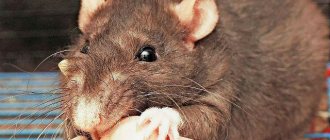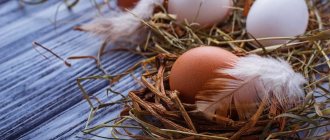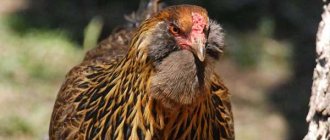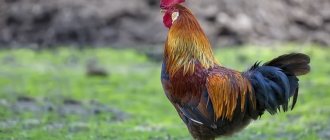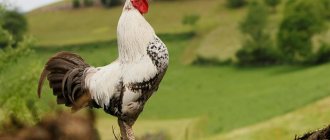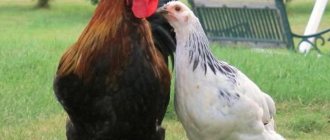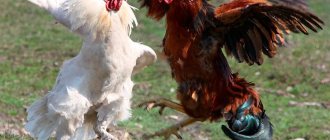2 039
no comments yet
2
Author:
Rasskazov Pavel.
Reading time: 2 minutes
Crowing for roosters is a way of vocal communication and roll call. If there are several roosters in the herd, then the leader always speaks first, and then the rest: this is how the hierarchy of birds is manifested.
If the subordinate rooster crows first, he is attacked by the leader.
Why does the rooster crow
There are other explanations for why a rooster crows:
- the rooster with his cry shows that the chickens around him are his flock and warns that no one can encroach on them;
- roll call. The crowing roosters check that all members of his flock are present. The chickens respond by clucking;
- competitions. Roosters often sing not alone, but in a flock. Thus, they compete in vocal abilities and charisma.
Birds, like other representatives of the animal world, have a biological clock, which is why roosters crow at certain times of the day. Even if you close the kochet in a dark room, it will still scream at the same time, thanks to the internal biological clock.
In the morning
The loud morning crow of roosters is due to their natural instincts. It is not associated with sunrise; birds are guided only by their own biological rhythms.
Crowing in the morning, the rooster shows itself as the owner of the territory and the flock, and also calls out to its relatives.
During the day
Daytime rooster crowing can be caused by various reasons:
- the male found food (or the owner brought it), and in this way he calls hens from the herd to share the prey;
- according to the rooster, the family or chicken coop is in danger, and in this way he warns his relatives about this;
- kochet supports hens during egg laying;
- roll call.
At night
At night, the activity of predators that can attack the herd increases. Most often, the crowing of a rooster at night signals a meeting with danger. And also at night the so-called first roosters crow.
There are also special vocal breeds whose singing has its own characteristics.
What does crowing mean according to folk signs?
It has long been believed that this bird can predict trouble. There are many folk signs associated with crowing.
Let's consider why a cockerel can crow, according to popular beliefs:
- If a bird screams very loudly and hits the windows, a fire may soon occur in the house.
- The cockerel lost his voice - to the illness of loved ones.
- If during dinner a Kochet runs into the house and jumps on the table, it means the death of one of the family members.
- A bird shaking its head for no reason means trouble.
- Waking up to the cry of a kochet in the morning means good luck and a good day.
- Kochet is bathing in dust - it will rain.
- Molting was considered a warning about good and warm weather.
- A rooster crow in broad daylight means unexpected changes in the owner’s life.
There are many reasons why roosters crow, but the main one is their instincts and biorhythms. If you don’t like your bird screaming too loudly, then you should resort to the methods described above to get rid of it.
Are addictive
Experts in the field of psychology have made a discovery: raising chickens can cause addiction in humans. This phenomenon occurs as follows: starting to breed poultry with a small chicken family of 5-10 individuals, a person can become addicted to the process and subsequently his farm may already have up to 200 individuals of different chicken breeds, with different indicators of egg production and productivity.
By the time the poultry farmer decides on his favorite breed, his farm can turn into a reputable poultry farm.
Important! Chickens love to drink water, and their egg production and well-being directly depend on this. Therefore, by reducing their drinking rates, breeders risk a reduction in their egg production of more than 15%.
Why do roosters crow?
It is known that wild roosters were domesticated as religious animals in ancient India in the 3rd-2nd millennium BC. e. It was thanks to its cry, which heralded the onset of a new day, that this bird became domesticated, and only in ancient Europe did chicken meat, and then eggs, begin to be eaten.
Therefore, nature has arranged for roosters, known bullies, to achieve the capture, development and defense of their territory in the most bloodless way possible - intimidating their fellow tribesmen with loud crowing. The rooster crows to show “who’s boss here,” so that none of the rival neighbors will have any doubts that he is the master of his plot and the master of his “harem.”
The crow of a rooster is one of the territorial acoustic signals that are very important in the communication of birds, especially wild ones. However, domestic roosters continue to inform the entire village about their rights to the yard with the chicken coop. Crowing is a kind of challenge to other roosters, to which they respond. If a rooster crows in the yard, occupying a subordinate position, then the leader simply attacks him without deigning to respond.
Legends, tales, beliefs
The cult of roosters was first mentioned in ancient India. Among the Indian people, this bird was a sacred animal, so it was forbidden to eat its meat. Hindus believed that the rooster is the messenger of the supreme gods to Earth. He was sent to herald the rising of the sun and the beginning of a new day. Hindus believed that if the sacred rooster in the temple does not crow, dawn will not come. The sacred bird was pampered in every possible way, fed well, and decorated with jewelry.
The Holy Quran also mentions the crowing of a rooster. The hadith of the Messenger of Allah says: “When you hear a rooster crowing, then ask Allah Almighty for mercy and goodness, for the rooster saw an angel.”
(that is, it was believed that the rooster crows every time he sees an angel).
There is a slightly fairy-tale explanation in the Mongolian epic. A long time ago, a rooster had a gorgeous tail of extraordinary beauty. Everyone looked at him as if he were a miracle. The peacock was jealous of such beauty and wanted to have the same decoration. Then one day he approached the rooster and said: “I’m going to a holiday. Would you lend me your tail for one day?
.
The rooster was kind and agreed. The peacock took the tail and never returned it. Since then, every morning the unfortunate rooster cries: “Ku-ka-re-ku!”
.
Which means: “Get your tail back!”
Of course, folk tales are unlikely to explain the true reason for the crowing of roosters. But it is so interesting to study the histories of different peoples and compare them with each other.
If roosters interfere with sleep
Male chickens sometimes sing at night, at one, two and four early in the morning. We have not yet come up with an effective way to prevent the rooster from crowing, especially at night. Some zoologists experimented by keeping the birds in a dark room for more than one day, but the singing schedule was still not disrupted. It is not always possible to change nature. Therefore, if roosters are crowing on your or a neighbor’s property, all you have to do is enjoy the beautiful iridescent sound.
Previously, cock crow served to tell time among many peoples and was taken for granted. It was only in the last century that scientists became interested in why the rooster crows and began to study this issue.
The answer to the question why roosters crow in the morning goes back to the wild ancestors of today's chickens, when each bird family occupied its own territory for living and foraging. There is a hierarchy among roosters. The leaders of the chicken family are allowed to sing first; the males of the “second rank” sing next. The young cockerel that gives its voice may be pecked for its insolence.
The following reasons can explain why a rooster crows:
- notifying others that the territory is occupied and the livestock has a strong and courageous leader;
- checking the flock for numbers (is everything in place);
- the news that morning has come.
During the day, roosters crow repeatedly, for each case there is a specific sound: calling the hens to the feeder or dissatisfaction with their behavior. But in everyday noise, crowing is less noticeable to people. At night, sounds travel over long distances, and the human ear perceives the crow of a rooster within a radius of two kilometers. Each singer has a unique tonality, which differs from the voices of their relatives by only half a tone.
A rooster can crow loudly during the day; this happens for certain reasons:
- there is a threat to the laying hens, a stranger has invaded the territory;
- challenge to fight for the primacy of other males;
- sudden change in weather.
A stressed bird often screams for no apparent reason. With the disappearance of the irritating factor, the male’s unusual behavior goes away. But there are individuals who, by their nature, are too loud. In this case, replacing the head of the chicken coop can help.
Attention of scientists
Italian scientists even conducted a special study with the goal of determining whose biological clock works most accurately. To do this, the behavior of several chickens, roosters, rabbits and two dozen scientists was observed for a week deep underground. It is not surprising that, following the results of the experiment, it was the scientists who were the first to “give up the race.” Morning roosters are distributed as follows: - the first roosters - at the first hour of the night; - second roosters - crowing at the second hour; - third roosters crow at four o'clock in the morning.
Many chicken breeders, village inhabitants and people visiting rural areas have been awakened more than once by rooster crows; they can also be heard at other times of the day. Etymologists have found that the rooster crows for a reason, it is his territorial acoustic, or sound, signal.
Without sounds, birds will not be able to communicate with each other. There is a wide variety of sounds in nature; wild chickens, whose habitat is thickets of bushes with a limited horizon, are especially distinguished by their roll calls.
The human ear can hear the crowing if the rooster is two kilometers away. This sound is single and long, at a high frequency. How long a male chicken crows depends on the circumstances and purpose of the cry. If the cockerel has found food, he will begin to make repeated sounds that serve as a call for the hens.
It is most effective when the rooster gives a loud, high-pitched signal for a long time. The crow of the same male cock is always pronounced almost identically, with deviations of no more than a semitone.
Scientists have long figured out why a rooster crows loudly, and why, when there is another male chicken, or several, nearby. The sound made can be a call, and brothers of the same rank as the rooster call in response. When a subordinate cockerel of lower rank raises a call in his yard, the dominant male attacks the one who dared to raise his voice; he does not give a sound response.
Features of character and lifestyle
Photo: Golden Rooster
Roosters are flocking birds. Like many galliformes, there is only one adult rooster in a flock, which has the right to mate with all the females, as well as several growing roosters. Adult roosters are expelled from the flock by the leader. If the owners of the flock do not seed them independently, then the weaker individuals will be constantly subject to pressure from the leader.
The rooster controls a certain number of hens. He looks for food for them, shares random prey, announces their daily routine - the chickens go together to sleep or to water. Roosters are not known for their docile nature - they are aggressive and lively birds, which is why they began to be used for bird fights.
Roosters are either indifferent or aggressive towards humans. These birds rarely show affection or interest in people. Most often, they seek to demonstrate their dominance by driving the stranger out of their territory.
Roosters and their flock of hens are territorial birds. They are not adapted to migration, so they prefer to always stay on one piece of land as long as it is able to feed them. Roosters move after fresh food. They spend winters comfortably in warm chicken coops.
Roosters are extremely thermophilic. They freeze quickly in the cold because they do not have any protective mechanisms against getting cold, unlike other birds such as partridges, pigeons or crows.
Roosters are also prone to molting, which occurs in late autumn - early winter. Their top layer of hard feathers falls off, in their place new feathers will grow by the next summer season. Roosters sleep with their heads hidden under their wings and standing on one leg.
Signal of intimidation
The cockcrow itself is a signal for a potential rival, a way to indicate the owner of the territory.
In their natural habitat, all animals have their own specific area where they feed and reproduce. Protecting him and protecting themselves is a task set before them by nature itself. Brutal battles, injuries received in them, and even more so the death of males fighting for their territory have a bad effect on the population and are harmful to the species. Roosters, known bullies, can resolve these issues without bloodshed - simply by intimidating those around them with loud crowing.
The first crow is heard already at dawn - as soon as he wakes up, he hurries to declare himself and his territorial rights to others. This is determined by the biological clock, daily rhythm and characteristics of the central nervous system of the bird. However, this does not answer the question of how roosters determine time. The most common version today is based on the location of the stars.
In his book “The World of Our Senses,” Lev Ekonomov says that zoologists’ attempts to crow roosters with the location of the stars led to surprising conclusions. It turned out that the first roosters begin to crow as soon as Canopus (a star from the constellation Carina) lights up in the sky, and when it disappears beyond the horizon, the second roosters start crowing.
The reasons for the third roosters are still an unclear fact, as is how these birds manage to navigate by the stars while sitting in a closed chicken coop.
Interesting facts about roosters
- There is an all-black breed of roosters called Ayam Chemani. There is a gene in their genome that causes too much pigmentation. Moreover, it is dominant, that is, it is constantly transmitted with 100% probability. The interesting thing is that these birds are not only black on the outside. Their bones and internal organs are also the color of night. Even the blood is much darker than other breeds.
- They have their own language. However, like chickens. People think that these are meaningless clicks or cackles, but in fact, scientists have already been able to identify 30 sounds with different meanings. For example, a chicken may announce that it will lay an egg or signal to its relatives that there are a large number of worms.
- Able to empathize with other birds. It has also been proven that birds feel sad when away from a group.
- They are very smart, as they are able to remember up to 100 faces and how this character relates to them. Birds make decisions based on their experience. They can also be taught arithmetic.
- Together with chickens, they are direct descendants of the Tyrannosaurus rex. Surprising, considering that it was one of the largest predators to ever exist on our planet.
- Dream books describe the meaning of a dream in which a person lost a rooster. This suggests that he avoided a possible meeting with an unpleasant type, a competitor. This is if it is a man. If a woman had a dream where a bird disappeared, then she may have lost a admirer. There are also recommendations in case you had a dream about a rooster. For example, if you hear him scream, you need to take a decisive step so as not to miss the opportunity that now exists.
Bonus fact: the largest rooster in the world was bred by breeders. Height is 91 cm and weight is 11 kg. This is an ideal breed because it produces a lot of tasty meat.
Chickens can communicate
People think that chickens communicate with each other simply by clicking and clucking, but in fact, it is the language of communication. Researchers have described over thirty different meanings of bird “conversation,” including “it’s time for me to get laid,” “come quickly, everyone is here, there’s a lot of food!”, as well as the call of partners during the mating season and a signal about the approach of predators. Mother hens can quietly communicate with embryos that are still in the egg. And a few days before birth, chicks can already respond to their mother with certain sounds expressing pleasure or anxiety, if the mother herself is calm or anxious.
Later, while walking with the brood, the quonka constantly teaches the chicks, making various sounds warning of danger, or calling them to peck something, and the babies quickly respond to the call, hiding under their mother or gathering in a group near the food.
Interesting facts about roosters
Sometimes an unusual question arises: is the rooster a bird or an animal? But this is not quite the correct way to pose the question. The fact is that animals include all living organisms that feed on other living organisms.
Gallic rooster
Animals are vertebrate mammals in which offspring appear immediately in the form of cubs. Therefore, we can confidently say that a rooster is a bird. And there are many interesting facts related to it:
- Among the Slavs, the rooster was considered a kind of alarm clock. Usually, with his first cry, the peasants woke up, with the second they went to milk the cows, and after the third they gathered in the field.
- Crowing used to symbolize the coming of morning. It dispersed evil forces.
- The rooster is a social creature. If he spends a long time outside the pack, he will suffer and get sick.
- There is information about a rooster that lived for 18 months without a head. These events are known as "the life of headless Mike".
- These poultry have a very good memory. They can remember those who did something good or bad to them.
- If someone dreams of a crowing rooster, it means they should expect good news.
Additional Information. The image of a rooster appears on the coat of arms of the French national football team.
Heraldry[edit]
"Armoral" animal of Gaul (France) and St. Galla (Gallunus). The rooster became the emblem of France thanks to a play on words of the Latin language, in which the word “gallus” means both “rooster” and “gall” - the ancient name of the inhabitants of France. It should be noted that the Gauls themselves willingly painted the image of a rooster on their banners and weapons...
Widespread on coats of arms and banners after the French Revolution and widespread interest in antiquity in the end. XVIII century. Napoleon replaces it with the imperial eagle. The unofficial emblem of the July Revolution of 1830, which was joined in the 60s of the same century by Marianne - an allegory of France. The gradual redistribution of everything positive to Marianne, and everything negative to the poor rooster (adventurism, cockiness, untenable political ambitions, arrogance and conceit) is largely due to the efforts of cartoonists.
De Gaulle introduced it into military medals as a symbol of the fighting spirit of France.
Emblem of the French National Olympic Committee.
The coat of arms of Kenya shows vigilance and national revival, holding an ax in his raised paw
It can symbolize both military courage and religious inspiration.
See Rooster in heraldry
- The beak (singing), comb, and beard can be distinguished by color.
- Raised leg - readiness to fight.
Why do roosters crow in the morning?
Many people are interested in how a rooster crows. In fact, this is the familiar “crow”. Moreover, in different countries they hear completely different things. This is probably why birds do not understand people when they try to imitate the voice of a rooster.
The reason why the rooster crows in the morning lies in the hierarchy of animals. The proud alpha male makes a sound first early in the morning, followed by low-ranking individuals. In this way, places in the hierarchy are distributed among the roosters. In addition, crowing is a way of marking territory and warning enemies that they will be in trouble if they decide to be intruders.
Why do roosters crow in the morning?
What time do the roosters start crowing? The time when they make their first sounds is determined by the birds' biological clock. The first roosters start crowing at 1.00, the second at 2.00, and the third at 4.00. But depending on the conditions and biological characteristics of a particular rooster, the time may vary. The researchers also noticed that the time the rooster crows is related to the location of the stars in the sky. So, the first roosters begin to crow when the star Canopus appears above the horizon, and when it disappears, they stop. The third rooster often coincides with dawn.
The question is, why do people need to know what time the roosters crow? And the explanation is very simple. In the village, when there was no clock yet, this was one of the landmarks when to set off on the road (waiting for the first roosters was considered a good omen), the second was often a signal to go milk the cows. Well, the third is a sign that you need to get up and get ready for your daily work. In general, like a village alarm clock. When a bird crows, you can immediately tell what time it is.
For your information!
Few people know that a rooster can also cluck like a chicken, and they do this to call their “friend” to eat.
Mother hens
Brood hens lay eggs and sit on them until the chicks hatch. They need privacy. If a person or other birds disturb her during this action, she may growl. Yes, can you imagine, a chicken can roar! In this way she warns that she should not be disturbed - the hen wants to become a mother. If you do not move away from the nest in time, the hen will begin to painfully peck the troublemaker until he leaves.
Some hens make sounds like squealing or even screaming, and also fluff up and look with an angry look, trying to ward off the uninvited guest with all their appearance.
Typically, a brood hen leaves the nest once a day. At this moment, she fluffs up her feathers, clucks quite often and always looks a little irritated. Most likely, this is the chicken’s way of showing that now it is better not to disturb her or touch her.
If you observe, you will notice that other birds avoid the hen. Thus, she shows herself in the role of a “good mother” who will always be able to protect her offspring.
Features of feeding
The diet of roosters is the same as that of chickens. There are differences to consider though. The bird should be fed based on the purpose for which it is kept: for slaughter, for reproduction or participation in battles.
The standard diet should include grain mixtures, feed containing animal protein, vegetables, fruits and herbs. As well as mineral supplements.
A breeding rooster should not be overfed. Increased weight and obesity have a bad effect on the activity of males during mating. There are special feeds that contain additives that have a positive effect on the potency of males.
Males for slaughter, on the contrary, must quickly and actively gain weight. They buy high-calorie food for them. Eggs and cottage cheese are included in the diet. Feeders should always be full. You can use special feed for broilers.
Fighting cocks must be strong, healthy and active. They are given food with a high vitamin content. Dairy products, meat and eggs are also included in the diet.
Lifespan
In the wild, chickens can live an average of 13 years. But with proper care at home, the life expectancy of birds can reach 30 years. In practice, this rarely happens, since everyone makes mistakes in care, and the bird itself may be genetically weak or raised in conditions conducive to the occurrence of diseases.
It also all depends on the purpose of raising roosters. As a rule, this is a continuation of the chicken family. Therefore, roosters live as long as the period of active fertilization lasts. On average it is 4 years. As soon as the rooster becomes a weak male, he is sent along with the chickens to slaughter. Well, there’s nowhere to put it, it’s so useless, but it will still be useful. Normally, 1 male should fertilize 10 females.
Note!
How many years roosters live depends on the quality of food, the temperature in the chicken coop and many other factors (a skilled poultry farmer should prevent fights between roosters, as they negatively affect the psyche of the animals).
What to do if the rooster crows loudly?
The scientific explanation for the phenomenon of rooster crow is based on territorial characteristics. The alpha male crows, notifying potential rivals that he is the master in this area and should not be disturbed. Other available conclusions are based on observations and experience of chicken farm owners and are speculative in nature, since they apply to a number of special cases, but do not fully explain the behavior of the bird.
It has been proven that a rooster crows in the following cases:
- in case of “unauthorized” intrusion into the territory of an open range or into the premises of a chicken coop by strangers (strangers, wild or domestic animals and birds);
- on the eve of upcoming weather changes;
- at dawn.
The male has many other sounds in his “vocabulary” that he uses in order to:
- warn chickens and offspring about the danger;
- invite them to share a meal;
- to pull down his fellow tribesmen who were “insolent,” from his point of view.
But these messages go unnoticed by people, since they are significantly inferior in pressure and volume to crowing.
Some particularly zealous individuals can crow around the clock with short breaks for food and sleep. This behavior can only be explained by some deviations in the genetic code. Experienced poultry farmers believe that these manifestations may be a consequence of breed costs.
It was noticed that on the territory of our country, uncontrollable screamers are most often found among breeds derived from the Yurlovka vociferous (the second part of the name explains everything), such as:
- Zagorsk salmon;
- Moscow black;
- Adler silver;
- May Day.
A comparative analysis of the propensity for curing of meat and egg-bearing breeds showed that “leadership” belongs to the latter.
There are several effective methods to make a bird quieter:
1. If the rooster constantly crows at night or wakes up his owners too early in the morning, you can try placing him at this time of day in a dark room with limited but sufficient space for air access. This will moderate the feathered ardor without affecting the behavior as a whole.
It is important to remember that subsequently it must be released into bright light gradually; a sudden transition can cause stress in the bird. 2. There is a strict hierarchy in the chicken coop.
If there are several males, seniority belongs to only one. The alpha male takes precedence in mating and vocalization. During the morning roll call, the remaining roosters have the right to vote only after the leader. Any attacks on the authority of the alpha male are severely suppressed. If you add an older and more physically powerful rooster to a chicken coop with a frantic screamer, the problem will be solved very quickly. 3. Another way to make the male behave more quietly is to make a collar from a piece of fabric tape with Velcro. An element with a double-sided working surface is suitable for these purposes. A piece larger than the diameter of the bird's neck is cut off. The plumage on the withers rises. The collar wraps loosely around the neck and is fastened with Velcro. The effect is that the rooster will not be able to take in enough air to crow loudly. He crows, but quietly, in a whisper.
Scream volume
The volume of a cockerel's crow can reach 90 decibels. A dog's barking, for example, is not much different from crowing.
A crowing rooster is much quieter than the engine of an old tractor plowing a field. Some electric instruments operate with louder sounds.
But the crow of a rooster can become an irritating factor for an unprepared person. This is because males cannot be silenced at night or early in the morning. All the same dogs can be weaned from barking.
Background
History says that a bright and vocal bird called “rooster” was domesticated back in the 3rd-2nd millennium BC. This happened in the territory of Ancient India, where this bird was considered sacred and many properties were attributed to it.
Since the rooster was considered a cult bird, it and chicken in general were not eaten then. Violation of this rule was considered a very serious crime, so violators were severely punished. They were kept in houses not as a useful household item, but as a protector from evil spirits and a harbinger of a new day.
People began to eat rooster meat much later. This happened on the territory of medieval Europe. Although here the roosters were treated with respect. They were valued for their loud voice, and it was here that houses began to be decorated with outbuildings depicting the silhouette of a singing rooster.
How to reduce voice activity
Sometimes too loud rooster crow causes inconvenience to the poultry farmer and his neighbors. There are several methods for weaning a male from the habit of screaming loudly and often. However, it should be remembered that crowing is a normal behavior of a healthy bird, so before getting chickens and roosters, you should evaluate whether you can tolerate their loud singing.
There are breeds that are more prone to loudness. If the birder is not prepared for loud and frequent singing, these breeds should be avoided:
Why did the bird stop crowing?
You can get used to the loud cries of a rooster, but its silence is a reason to think about the health of the bird.
A cockerel may stop crowing for several reasons:
- Infectious bronchitis is a disease of the respiratory organs, which, unfortunately, has no cure. However, the meat of a sick bird will not harm a person.
- Bronchopneumonia - with this disease, the kochet begins to wheeze. The sick rooster is isolated, treated with antibiotics, and after a week is returned to the chicken coop.
- Colibacillosis is caused by E. coli. It affects the internal organs of the bird. Treated with antibiotics.
- Molting - the cockerel becomes silent only for the period of molting, after which it begins to sing again.
- The aging process - with age, birds begin to wheeze and may stop screaming altogether.
- Changes in hormonal levels.
Important! If you are unsure of the reason why your rooster has stopped singing, be sure to contact your veterinarian. If an infectious disease is detected, this will help prevent infection of other inhabitants of the chicken coop.
Disturbing silence
But why the rooster stopped crowing needs to be clarified as soon as possible. A bird’s voice doesn’t just disappear like that. Most often, the cause is a variety of respiratory diseases, which can soon lead to the death of the individual. Indirect symptoms of this will be rapid or intermittent breathing, coupled with paleness of the comb.
Sometimes the rooster is silent during the molt. If so, he will resume his songs when the difficult period is behind him.
We invite you to familiarize yourself with Soda - beneficial properties, use and treatment with soda || What is baking soda made from?
The worst thing is if, due to a recent illness, the rooster “changed sex.” This does not mean that he became a chicken, but internally he stopped perceiving himself as a male, a leader. He loses interest in his harem and ceases to defend his accountable territory.
The bird should be taken to a veterinarian immediately. In most cases (except molting), the rooster must be replaced.
Mechanism of the mating process
Chickens are birds that live only in flocks and never alone. Any flock has its own rooster - the leader. The leader has access to any chicken at any time and can trample them as many times as he needs. If this right is somehow limited by other males, then fights occur, sometimes ending in bloodshed.
Ritual games are an important stage in the mating process. The rooster does not immediately trample the hens, at first he usually spins around the female and begins to lower one wing. After some time he begins to stomp. During the mating process, the rooster jumps on the hen, tramples her and with his beak grabs the female by the feathers on the back of her head.
Chickens reproduce using the cloaca, an expanded part of the intestine that opens outward through a hole under the tail. When a rooster tramples a hen, the birds' cloaca is everted and the rooster's testes come into contact with the hen's cloaca. At the same time, seminal fluid is released, which enters the female’s genital tract. The seed can remain active in the hen’s reproductive tract for about 20 days, and all the eggs she lays during this period will be fertilized and ready to hatch.
Mating proceeds very quickly, this process is repeated quite often. A healthy male is capable of mating up to 22 times a day, and the quality of the sperm depends on the frequency of this process. If a rooster tramples hens too often, the sperm concentration decreases significantly
And, conversely, with a decrease in the number of copulations, the concentration of germ cells in the seminal fluid increases. In order to maintain flock numbers and ensure a high rate of fertilized eggs, it is important to determine how many roosters should be kept in the flock
Fertilization
Chickens, like most other birds, have love etiquette and rules of behavior in the flock. The rooster is the leader to whom the hens obey unquestioningly. The leader may have his own favorites with whom he shares food.
- When flirting, the male sedately walks around the hen and scratches his wing with his paw.
- The mating process begins with the rooster climbing onto the hen and moving his paws over it, trying to find the recess provided by nature on the back, “tramping” the hen.
- The beak grabs her head and mating begins: a brief contact of the partners' cloaches. At this moment, the seminal fluid penetrates the oviduct and fertilization of the egg occurs.
- During mating, while the rooster holds the hen's head with his beak, the organisms of both birds are preparing for fertilization. During the process of trampling, the cloaca of the partners is slightly turned out. In males, the gonads are located on the inside of the cloaca, near the outlet.
- The seminal fluid remains in the laying hen's body for up to 20 days. During this entire period of time, fertilization of the eggs occurs. It penetrates through their soft shell, not yet covered with a shell. Whether there is an embryo in the egg is determined using an ovoscope. This is a device designed to illuminate the shell.
The sexual activity of roosters varies. Some males are capable of 20 matings per day. In order to properly plan housekeeping, you need to know at what age a rooster begins to trample hens.
Males begin to be active in this matter only after they crow. That is, not earlier than 5-6 months.
Sexual function is affected by:
- The presence of adult and aggressive rivals;
- Features of the breed;
- Quality and sufficiency of feed;
- Conditions of detention.
Reproductive capacity decreases or is completely lost during molting. More often this happens in the fall, but there is no exact time frame.
Rooster bird. Rooster lifestyle and habitat
True, the Rooster cannot be called cowardly - if the need arises, he will really show courage. However, he says much more than he can do. A braggart, in a word. He is pleasant to talk to, but not very good in intimate relationships. The Rooster is quite lazy, and if hard work awakens in him, it is in a somewhat strange form. He always wants to do more than he can, sets himself impossible tasks and is very upset when he fails to complete them well. And yet, life forces the Rooster to be active. Nothing comes to him without difficulty - he is forced to work to ensure a decent existence. If the field of activity is favorable, he may become rich. However, he is able to extract money even from a thankless field. The Vietnamese say that since the Rooster has to “scrape with both beak and paws,” he will always find a worm, even in the desert. In a word, the Rooster is constantly at work. But if he allows laziness and daydreaming to take over, he will most likely sink to the very bottom
Although, maybe this is also one of the ways to attract attention? The Rooster is inclined to engage in agriculture and work that requires communication with other people. Needless to say, the Rooster loves to show off, and therefore, no matter how much he earns, he will spend every penny
He is often at financial risk. He is not an economist by nature, so bankruptcy may well befall him. In love, he also has to work to win and keep his loved one. The Rooster can disappoint anyone, because reality, as a rule, does not correspond to the dream. The Rooster man loves the company of women, among whom he can shine and show off, care for and feel admiration. True, things don’t go further than this. He doesn’t have too many friends—he’s not particularly interested in male society. The Rooster woman, on the contrary, loves the company of other women, and therefore chooses to work with a female team. Throughout his life, the Rooster experiences ups and downs, both in the area of finances and in the area of feelings. But his old age will be happy.
Rooster fertility
Bettas begin to show interest in the opposite sex at 3 months of age. Males of light breeds are able to mate up to several dozen times a day, coping with a load of 25 hens. Representatives of heavy breeds manage to fertilize up to 20 females with a mating frequency of no more than 10 times.
The fertilization rate of eggs is affected not only by the number of roosters in the poultry yard, but also by their age. It is more difficult for young males to communicate with the weaker sex, who, due to timidity, spend a lot of time on courtship. Placed in a poultry house, they huddle together and try to stay apart somewhere in a secluded corner. Adult chickens intimidate young cockerels and do not allow them to approach the feeders. Therefore, often the poultry farmer, in order to avoid such treatment of the stronger sex, first introduces cockerels into the chicken coop, and then lets hens in with them. Then the hens stop feeling like they are the masters and show more delicate behavior.
When the voice appears
Related publications
Pets: proper dog care
Aug 22, 2020
Methods for transporting pets
Aug 5, 2020
At 2.5–3 months, young males try their volume. Their first singing is funny and sounds like a squeak. By 4–5 months, roosters master the technique of crowing and at first can crow constantly. Previously, well-groomed males learn to vocalize by the hour; their weak and unkempt counterparts noticeably lag behind.
Experienced farmers closely monitor the attempts of young roosters to learn to crow and cull individuals that have not yet learned to crow.
Specifics of courtship of the opposite sex
In the process of courting females, the rooster is an exemplary gentleman, using a whole set of simple techniques:
- Luring the “lady of the heart” to the food. The rooster takes food (a grain or a worm) with his beak, demonstrates it and loudly calls the hens. If none of them responded to the call, he pecks at the food himself; If several hens come running, he gives the prey to the one that got there first.
- "Stumbling" on the wing. When the hen approaches, it walks around it, periodically touching its wing with loose feathers with its foot.
- Pursuit of a female. While running after the hen, the rooster stretches its neck, bends its head to the ground, and ruffles its feathers. This method is more often used for unfamiliar females, representatives of someone else’s poultry house.
The rooster may show indifference to some hens of his flock, and they lay unfertilized eggs. Therefore, some owners who want to get a larger offspring are forced to keep 2 roosters in one flock.




